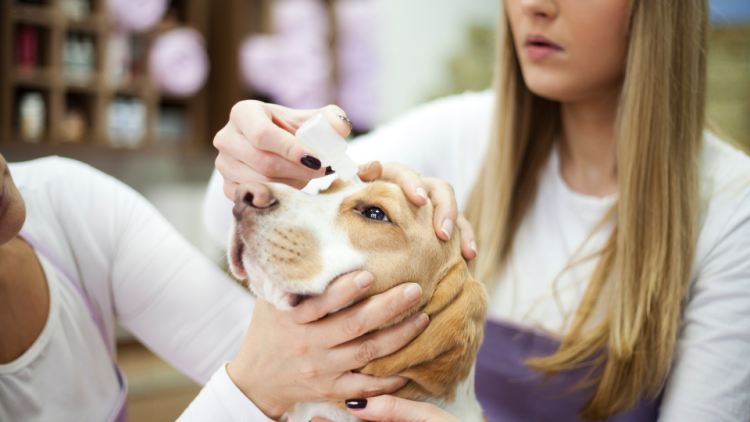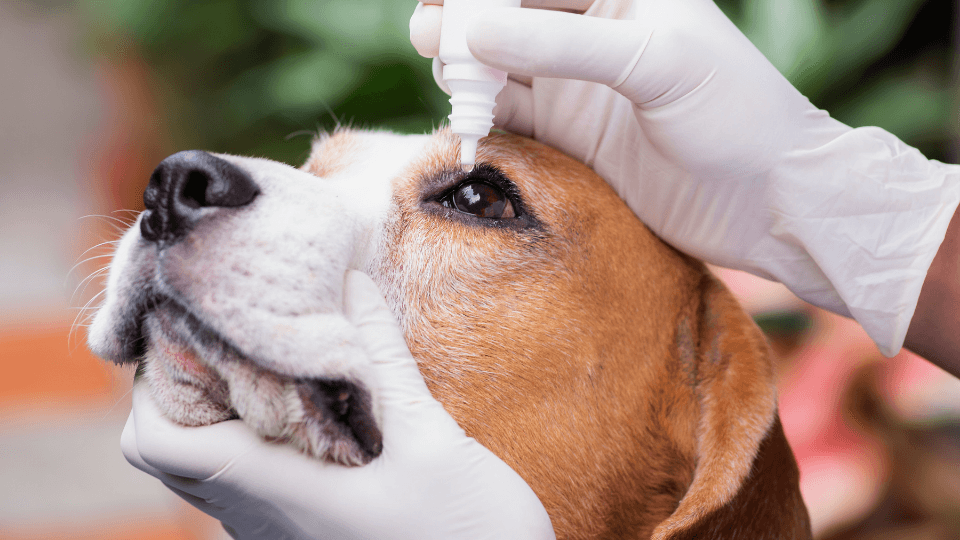Glaucoma is a condition of the eye in which a build-up of fluid creates pressure that usually damages the retina and optic nerve. Unfortunately, this painful condition is the most common cause of blindness in dogs - but that’s not to say there’s nothing that can be done to improve the dog’s quality of life.
In this article, we’re looking at the causes of glaucoma in dogs, the most common symptoms to watch out for, and treatments that can help manage the condition.
Table of Contents:
- What is glaucoma?
- What causes glaucoma in dogs?
- What are the symptoms of glaucoma in dogs?
- How to treat glaucoma in dogs
- How to prevent glaucoma in dogs
- Key Takeaways
Pro Tip: Treating severe eye disorders like glaucoma can cost thousands of dollars. Pet insurance can help you pay for expensive vet care if your dog develops the condition after the policy enrollment date.
What is glaucoma?
Glaucoma is the condition of increased pressure within the eye (known as intraocular pressure). Normally, pressure is regulated by fluid flowing into and out of the eye. When the normal outflow of this aqueous fluid is impaired, the pressure in the eye will increase, causing damage to the optic nerve and the retina.
If glaucoma becomes chronic or is left untreated, it can cause permanent damage and result in vision loss. About 40% of dogs with this condition will go blind within a year.
Dog breeds prone to glaucoma
Glaucoma can affect all dogs, but certain breeds are genetically predisposed to the condition. This list includes Beagles, Boston Terriers, Basset Hounds, Shar-Peis, and Cocker Spaniels. Other breeds that are commonly affected include Samoyeds, Siberian Huskies, Toy Poodles, and Labrador Retrievers.
What causes glaucoma in dogs?
The cause of glaucoma in dogs depends on whether the condition is considered primary or secondary.
Primary glaucoma refers to the increase of pressure within a healthy eye due to anatomical abnormalities inherited at birth. Dogs can develop primary glaucoma at any age, but most pups with this condition are diagnosed around three to seven years old.
Secondary glaucoma results in increased intraocular pressure caused by eye diseases or injuries to the eye. Common triggers include eye inflammation, tumors, infections, retinal detachment, and advanced cataracts.
What are the symptoms of glaucoma in dogs?
Common clinical signs of canine glaucoma include:
- Mild to severe eye pain that causes your pet to partially close or rub their eye
- The appearance of blood vessels in the white of the eye, or “red-eye”
- Impaired vision as demonstrated by issues finding things, bumping into objects, or walking cautiously

Other symptoms of glaucoma in dogs include watery discharge from the eye, swollen and bulged eyeball, tearing, squinting, avoiding light, fluttering eyelid, weak blink reflex, a cloudy cornea (the transparent part that covers the front portion of the eye), and pupils different in size.
The dog might also exhibit signs not directly related to the eyes, such as loss of appetite, lethargy, and even unresponsiveness.
In cases of acute glaucoma, all of these symptoms can occur suddenly, compared to chronic glaucoma that develops more slowly over time. As your pet ages, these signs might occur in one eye and then the other. In rare cases, glaucoma affects both eyes from the start.
If you spot any symptoms of dog glaucoma, be sure to get to the vet right away. The longer the pressure is sustained, the likelier your pet is to lose their vision.
Diagnosing glaucoma in dogs
Your vet will ask about your dog’s medical history, the onset of clinical signs, and possible incidents or injuries to the eye that could trigger secondary glaucoma.
Then, the vet will perform a physical exam and test the pressure within your pet’s eyes using a device called a tonometer. If the condition occurred suddenly, the vet would likely refer you to a veterinary ophthalmologist (a doctor who specializes in eye health) to examine both eyes. The ophthalmologist will perform electroretinography to measure the electrical activity of the retina and determine whether the dog’s eye will remain blind.
In the case of secondary disease, an ultrasound or X-ray might show abnormalities inside the eye.
How to treat glaucoma in dogs
Glaucoma in dog treatments will depend on the severity of the condition as well as any underlying health issue that might be causing glaucoma. The most common ways to treat glaucoma in dogs include medication, cyclocryotherapy, and surgery.

-
Medications help reduce the pressure in the eye to alleviate pain and preserve the animal’s sight. Most glaucoma prescriptions come in the form of ointments, topicals, or eye drops, all of which require a vet’s authorization. The vet might also prescribe oral pain relievers to help with the discomfort. If your dog’s condition is serious, they may recommend hospitalization in order to administer the drugs by injection and reduce the intraocular pressure faster.
-
Cyclocryotherapy (CCT for short) is a medical procedure that uses low temperatures (-112°F) to destroy the ciliary body, i.e., the cells that produce intraocular fluid. If detected early, this technique can slow down further progression or stop it altogether.
-
Surgery may be necessary if the condition is left undetected or untreated for a sustained period of time, leading to critical damage of the optical nerve. This procedure involves the surgical removal of the eye (enucleation), and though such measures may sound severe, pets will experience great relief and feel so much better after they heal from surgery.
Pro Tip: Pet insurance can cover a broad range of surgeries. Depending on your pet insurance plan, covered veterinary services may include repaired ligaments torn by an injury, enucleation due to a congenital disease, removal of cancerous tissue growth, and even spay/neuter surgery included under pet wellness plans.
Prognosis and recovery
The prognosis largely depends on the underlying cause of the dog’s glaucoma. When it comes to secondary glaucoma, there’s a possibility for a cure, whereas in the case of primary glaucoma, there’s no cure, but there are ways to treat and manage the condition.
Lifelong treatment will be necessary to keep the condition under control. Your pet will need to revisit the vet on a regular basis in order to have the intraocular pressure assessed. The vet will also want to ensure that your pet is responding well to the treatment and adjust the therapy if necessary.
Considering that 50% of dogs with primary glaucoma are expected to develop complications in the unaffected eye, a veterinary ophthalmologist will also need to examine the healthy eye** to determine the risk and prescribe preventive medication.
For dog breeds genetically predisposed to glaucoma, checkups every six months can help with early detection, thereby decreasing the chance of blindness and improving the pet’s overall quality of life in the years to come.
How to prevent glaucoma in dogs
Secondary glaucoma is preventable by maintaining pets’ optimal health, avoiding trauma to their orbital area, and seeking timely treatment for infections (especially those related to the eyes).
Primary glaucoma, on the other hand, can’t be prevented because it’s the result of genetics. However, even though there is no definitive way to determine whether a dog will get glaucoma, there are a few tests such as the ocular ultrasound and gonioscopy that can be used to examine the pet’s eyes (especially in predisposed breeds) and assess the risk.
Additionally, there are certain steps pet parents can take to slow down degenerative changes to their pet’s eyes and decrease the probability of the condition’s development. These steps include giving the dog antioxidants to reduce oxidative damage throughout the entire body, including the eyes, as well as minimizing environmental stressors that contribute to adverse health effects.
Early detection and treatment is the best way to prevent the progression of glaucoma and increase the likelihood of maintaining the dog’s vision.
Key Takeaways
- Glaucoma (elevated pressure within the eye) is a painful condition that, if left untreated, often causes loss of vision.
- There are two main types of glaucoma in dogs, primary and secondary, which can either be chronic or acute.
- Many dogs with glaucoma will end up blind, even with treatment, but early detection can help them keep their sight for as long as possible.
- There is no cure for glaucoma, but most cases can be managed with eye drops and medication prescribed by a veterinarian.
- If your dog has symptoms of glaucoma, be sure to see your veterinarian right away.
